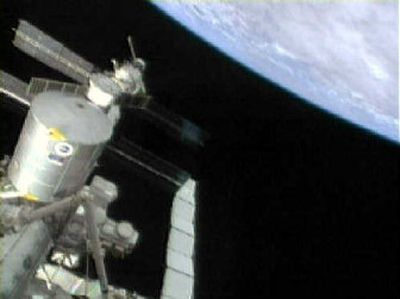Dangling ‘gap fillers’ may be threat to shuttle

SPACE CENTER, Houston – A couple of short strips of material dangling from Discovery’s belly may require an unprecedented repair by spacewalking astronauts if engineers determine there’s even a possibility that the problem could endanger the space shuttle during descent, NASA said Sunday.
Teams of experts are scrambling to understand just how serious the problem is, with heated discussions raging on what to do, if anything.
The trouble has nothing to do with foam or other launch debris but rather the accidental slippage of ceramic-fiber fabric used to fill the thin gaps between thermal tiles.
When the analysis is complete, mission managers will decide whether to have the crew’s two spacewalkers cut or pull the hanging material.
If the National Aeronautics and Space Administration’s spacewalking specialists come up with a relatively easy solution, “Why worry? Why would you not just go take care of it?” deputy shuttle program manager Wayne Hale said Sunday evening. “Why should I lose sleep over these gap fillers if we can take care of them that easy?”
Discovery and its crew of seven may be perfectly safe to fly back with the two drooping pieces in a week, officials stressed, as space shuttles have done many times before, although not necessarily with dangling pieces as large.
Hale, in fact, did not think it was that big a deal when he first learned of the problem a few days ago.
“My immediate knee-jerk reaction was that we can live with this,” he said. “On the other hand, this is bigger than we’ve seen before.”
One piece is sticking out 1.1 inches between the thermal tiles, the other protrudes at an angle from six-tenths to nine-tenths of an inch. For those areas, far forward near the nose, the general wisdom and flight history indicate that the limit should be a quarter-inch, said flight director Paul Hill.
Hill noted, however, that the quarter-inch measurement was taken following previous re-entries and the intense heat could have burned some of the material off. Discovery’s flaws were spotted in orbit – a first – because of all the photography and laser imaging being aimed at normally hard-to-see spots.
On a flight by Columbia in 1995, the shuttle returned with a gap filler that protruded six-tenths of an inch, but it was rolled up and located farther back on the belly, in an area less likely to overheat, said Steve Poulos, manager of the orbiter project office. When unrolled, the strip of material stretched 1.4 inches long. The only overheating effect was to nearby damaged tiles.
The extremely thin gap fillers are held in place with glue and by the tight fit of the thermal tiles; thousands cover the shuttle. Poulos speculated that the glue may have come loose.
Any repair, if deemed necessary, would most likely be performed during the third and final spacewalk of the mission on Wednesday, although a fourth unplanned spacewalk might be required. The second spacewalk, for space station repairs, is set for today.
The astronaut would have to stand on either the shuttle or station’s 50-foot robotic arm in order to reach the two hanging strips of filler. There are drawbacks to using either arm, namely clearance and time constraints. There’s also the possibility, however remote, that the spacewalker or the arm might damage something.
“There are pretty strong arguments for and against most of the options,” Hill said.
One extreme option would be to put an astronaut on the end of the brand new 100-foot inspection crane, but it would likely be a bouncy ride, and that makes spacewalk and robotic specialists nervous. Poulos said Sunday that the option was considered but ruled out.
Anything dangling from the normally smooth bottom of the shuttle will overheat the area and downstream locations during re-entry; as it is, temperatures there typically hit 2,300 degrees.
A hole in Columbia’s left wing, carved out by a large chunk of flyaway fuel-tank foam, led to the spacecraft’s destruction during re-entry on Feb. 1, 2003. All seven astronauts were killed.
NASA has cleared Discovery’s thermal tiles for landing on Aug. 8; they constitute the vast majority of the shuttle’s exterior. The only remaining issues, before the final go-ahead can be given for descent, are the reinforced carbon panels that line the wings and nose cap and the two dragging gap fillers.